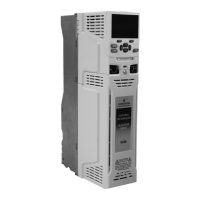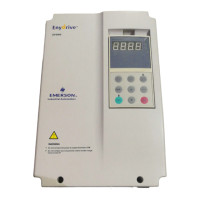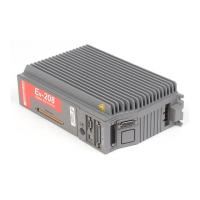Safety
information
Product
information
Mechanical
installation
Electrical
installation
Getting
started
User Menu A Commissioning
Advanced
Parameters
Diagnostics Optimization CT MODBUS RTU Technical Data
258 E300 Design Guide
Issue Number: 1
When set to Off (0), load cell compensation is disabled.
When set to On (1), load cell compensation is enabled.
Load cell compensation uses the elevator car load cell to generate a torque feed forward reference equivalent to the load torque preventing roll back
on brake release when starting the elevator.
Any of the 3 analogue inputs may be routed to Load Cell Compensation Input (E11), where it is expected that the output from the load cell is a
±10VDC type. Scaling and offsetting the load cell signal is achieved using the standard analog input features.
The load cell compensation is not applied during an autotune.
Figure 8-17 Load Cell Compensation
Start Lock Enable (I22) must not be used at the same time as load cell compensation Load Cell Compensation Enable (E10).
Load cell compensation uses the elevator car load cell to apply a torque reference to overcome the mass of the people in the elevator car when
running preventing roll back on brake release. The load cell compensation torque reference is sampled once.
Any analog input may be routed to Load Cell Compensation Input (E11). It is expected that the output from the load cell is a ±10 Vdc type suitable for
connection to the Unidrive M analog inputs. Scaling and offsetting the load cell signal is done using the standard analog input features.
On exit from state 2, (Elevator Software State (J03) = 2), the final load cell compensation torque reference is sampled once and used as a torque feed
forward reference. Sampling once prevents noise generated during travel, electrical or mechanical, from being detected by the load cell and injected
as a torque reference.
The following parameters affect load cell compensation:
This is the input to the load cell compensation scheme. Any analogue input may be routed to Load Cell Compensation Input (E11). It is expected that
the output from the load cell is a ±10 Vdc type and it is electrically connected to the analog input who’s destination is Load Cell Compensation Input
(E11). Scaling and offsetting the load cell signal is done using the standard analog input features.
E10 Load Cell Compensation Enable
Mode Open-Loop, RFC-A, RFC-S
Minimum 0 Maximum 1
Default 0 Units
Type 1 Bit User Save Update Rate 4 ms read
Display Format Standard Decimal Places 0
Coding RW
E11 Load Cell Compensation Input
Mode Open-Loop, RFC-A, RFC-S
Minimum -32768 Maximum 32767
Default 0 Units
Type 16 Bit User Save Update Rate 4 ms
Display Format Standard Decimal Places 0
Coding RW, PR
Load Cell Compensation Enable (E10)
Final Torque Reference (J27)
Load Cell Compensation Filter TC (E12)
+
+
0.1%
Torque
Load Cell Compensation Torque (E13)
Inertia compensation
Load Cell Compensation Input (E11)

